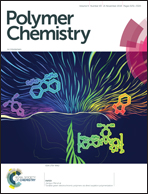Control of circularly polarized luminescence from a boron ketoiminate-based π-conjugated polymer via conformational locks†
Abstract
Circularly polarized luminescence (CPL) from well-organized structures of aggregates has been intensely investigated, while rational design of π-conjugated polymers with pronounced CPL signals at the unimolecular level remains challenging. Herein, we present the design and synthesis of a novel π-conjugated polymer (polymer-1) incorporating a boron ketoiminate unit and bearing a chiral pendant. CPL signals of the resulting polymer can be finely controlled by acquiring stable excited state conformations via conformational locks. Systematic spectroscopic (UV-vis, NMR, CD, fluorescence and CPL) analysis, microscopic studies and molecular dynamics simulations demonstrated that polymer-1 exhibited a CPL signal in a “good solvent” with a dissymmetry factor of ∼10−4 in a single helical form. The variation of the CPL signal was identical to the emission with an average dissymmetry factor (∼10−4) in the CHCl3 solvent with the increase in the concentration of MCH (methylcyclohexane). Modulating the CPL signals via conformational locks opens up a new perspective for the future development of smart CPL-active organic dyads.



 Please wait while we load your content...
Please wait while we load your content...